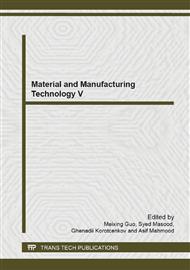[1]
B. Beamon, Measuring supply chain performance, International Journal of Operations & Production Management, vol. 19, no. 3, p.2752–92, (1999).
Google Scholar
[2]
A. Gunasekaran, C. Patel, and E. Tirtiroglu, Performance measure and metrics in a supply chain environment, International Journal of Operations & Production Management, vol. 21, p.71–87, (2001).
DOI: 10.1108/01443570110358468
Google Scholar
[3]
A. Charnes, W. Cooper, and E. Rhodes, Measuring the efficiency of decision making units, European J. Oper. Res., vol. 2, no. 6, p.429–444, (1978).
DOI: 10.1016/0377-2217(78)90138-8
Google Scholar
[4]
C. W. Z. J. Liang L, Yang F, Dea models for supply chain efficiency evaluation, Annals of Operations Research, vol. 145, no. 1, p.35–49, (2006).
DOI: 10.1007/s10479-006-0026-7
Google Scholar
[5]
Y. Chen and J. Zhu, Measuring information technology's indirect impact on firm performance, Information Technology and Management, vol. 5, p.9–22, (2004).
DOI: 10.1023/b:item.0000008075.43543.97
Google Scholar
[6]
C. Chen and H. Yan, Network DEA model for supply chain performance evaluation, European Journal of Operational Research, vol. 213, no. 1, p.147 – 155, (2011).
DOI: 10.1016/j.ejor.2011.03.010
Google Scholar
[7]
M. Tavana, H. Mirzagoltabar, S. M. Mirhedayatian, R. F. Saen, and M. Azadi, A new network epsilon-based {DEA} model for supply chain performance evaluation, Computers Industrial Engineering, vol. 66, no. 2, p.501 – 513, (2013).
DOI: 10.1016/j.cie.2013.07.016
Google Scholar
[8]
F. Yang, D. Wu, L. Liang, G. Bi, and D. D. Wu, Supply chain dea: production possibility set and performance evaluation model, Ann Oper Res, vol. 185, p.195–211, (2011).
DOI: 10.1007/s10479-008-0511-2
Google Scholar
[9]
G. E. Halkos, N. G. Tzeremes, and S. A. Kourtzidis. (2011, June) The use of supply chain dea models in operation management: a survey. [Online]. Available: http: /mpra. ub. uni-muenchen. de/31846.
Google Scholar
[10]
W. D. Cook, J. Zhu, G. Bi, and F. Yang, Network dea: Additive efficiency decomposition, European Journal of Operational Research, vol. 207, no. 1122-1129, (2010).
DOI: 10.1016/j.ejor.2010.05.006
Google Scholar
[11]
M. M. Marti, M. S. Novakovi, and A. Baggia, Data envelopment analysis - basic models and their utilization, Organizacija, vol. 42, no. 2, p.37–43, (2009).
DOI: 10.2478/v10051-009-0001-6
Google Scholar
[12]
W. Chaowarat and A. Sopadang, Performance measurement of supply chain management for export frozen food, " Master, s thesis, Chiang Mai University, (2011).
Google Scholar


